Feed aggregator
Comment on A Beginner’s Guide to Drucraft #30: Motion Sigls (II) by Kevin
Fascinating as always Steven hasn’t used any real Motion sigls yet and it’s nice to see some basic ones. Mark other sigls are probably a Shield and the Hurl sigl be interesting to see them in the future.
Would Calhoun using a Life reaction sigl versus a Motion speed sigl in the raid even though he specializes in Motion be because it was continuous and not triggered or is there another reason?
Sorcery & Small Magics by Maiga Doocy
YA / Fantasy
Leovander Loveage is a bit of a failure as a scryer. While other sorcerers are writing powerful and complex spells he is stuck writing small magic. His exact opposite is the intensely serious Sebastian Grimm. He is a magical prodigy…and they hate each other.
Until they are forced to partner in class. Leovander hands Grimm a spell to cast on him but the small magic he thought was being cast was somehow mixed up with a powerful curse. And they must somehow put aside their differences to break the curse.
I try to not compare books but I’m going to here. Sorcery & Small Magics gave me some of the same feelings as Darkwood by Gabby Hutchinson Crouch. Honestly that’s about the highest praise I can think of. I loved this book and I’m excited for the series to continue.

Mystery Walk limited edition from Lividian!
From Lividian Publications:
Mystery Walk by Robert McCammon
New Limited Edition Just Announced!
Lividian Publications is pleased to announce our signed, numbered, and slipcased Limited Edition hardcover of Mystery Walk by Robert McCammon, which will be shipping in May.
Featuring a breathtaking full-color dust jacket by Ben Baldwin and twelve striking black-and-white interior illustrations, this beautifully designed volume will be a must-have for any serious horror collector.
 Not ten minutes after that announcement came this:
Not ten minutes after that announcement came this:
Bad Moon Books
Buchheim Verlag (Germany)
Camelot Books
Cracked and Spineless Books (Australia)
Kathmandu Books
Midworld Press
Overlook Connection
SST Publications (UK)
Subterranean Press (link is directly to their order page)
Veryfinebooks
Ziesings
More news soon! Thank you for your continuing support and enthusiasm!
Best,
Brian
Comment on A Beginner’s Guide to Drucraft #30: Motion Sigls (II) by Celia
Interesting that Calhoun apparently uses a kinetic barrier rather than a kinetic shield. I guess doing so allows him to focus on offense as well as just defense? You’d think he’d want a sphere rather than the “curved barrier” we see in Chancery Lane though. The lack of a sphere almost got him shot in the back. And I can’t imagine he chose that shape due to financial issues? Unless Charles wants to keep him on his toes.
DOGE- Supernatural Division (episode 2)
A Sorceress Comes to Call - Book Review
 A Sorceress Comes to Callby T. Kingfisher
A Sorceress Comes to Callby T. KingfisherWhat is it about:A dark retelling of the Brothers Grimm's Goose Girl, rife with secrets, murder, and forbidden magic
Cordelia knows her mother is unusual. Their house doesn’t have any doors between rooms, and her mother doesn't allow Cordelia to have a single friend—unless you count Falada, her mother's beautiful white horse. The only time Cordelia feels truly free is on her daily rides with him. But more than simple eccentricity sets her mother apart. Other mothers don’t force their daughters to be silent and motionless for hours, sometimes days, on end. Other mothers aren’t sorcerers.
After a suspicious death in their small town, Cordelia’s mother insists they leave in the middle of the night, riding away on Falada’s sturdy back, leaving behind all Cordelia has ever known. They arrive at the remote country manor of a wealthy older man, the Squire, and his unwed sister, Hester. Cordelia’s mother intends to lure the Squire into marriage, and Cordelia knows this can only be bad news for the bumbling gentleman and his kind, intelligent sister.
Hester sees the way Cordelia shrinks away from her mother, how the young girl sits eerily still at dinner every night. Hester knows that to save her brother from bewitchment and to rescue the terrified Cordelia, she will have to face down a wicked witch of the worst kind.
What did I think of it:I've read several book by T. Kingfisher and loved them all. Still I kept mostly to her more horror-like books, with A Wizard's Guide to Defensive Baking the exception. I also had two more of her horror titles in my TBR when I received this book as a present. It had been on my radar (even had it in my greedy trotters when birthday shopping, but decided on another book), and the copy that I got was so pretty, and it had geese on the end-papers! So I immediately moved this to the top of TBR mountain.
And what a gorgeous, beautiful, amazing read!
This is a re-imagining of the faerie tale The Goose Girl. And it certainly has things that I recognize from the faerie tale, but mostly this is so much its own totally amazing story!
You get the story told from a couple of different viewpoints, mainly Cordelia and Hester.
I really liked Cordelia and felt for her. Her mother is a character I disliked and grew to hate the more I learned. I wanted Cordelia to find happiness.
I totally loved Hester! In her early 50's she has to deal with people thinking she's old, a bad knee, and her own insecurities. She also used to breed geese! I rooted for her even more than for Cordelia I can tell you.
(Voodoo Bride again wants me to add she really loved one of the male characters, and she says she wants a Richard of her own. Everyone needs someone like him in her opinion.)
There were several really cool other characters, and with how things were going I feared for a lot of them with good reason. This might be a retelling and not a horror story, there were enough bad things happening to keep me on edge.
After finishing this I had to take a breather before picking up my next book as I was still full of this one. You bet this will be reread and treasured! I will pick up one of the other Kingfisher books in my TBR soon.
Why should you read it:It's Absolutely Amazing!
Book Review: Grave Empire by Richard Swan
I received a review copy from the publisher. This does not affect the contents of my review and all opinions are my own.
Mogsy’s Rating: 4.5 of 5 stars
Genre: Fantasy
Series: Book 1 of The Great Silence
Publisher: Orbit (February 4, 2025)
Length: 529 pages
Author Information: Website
The Empire of the Wolf trilogy was one of the best and most compelling fantasy series I’ve read in years, so naturally I could not wait to get my hands on the next book by my newest favorite author Richard Swan. And with Grave Empire, Swan proves once more his talent in blending gripping storytelling with deep worldbuilding and complex political intrigue.
Though set in the same universe as the author’s previous series, this first volume of The Great Silence trilogy takes place many years later. So much time has passed that society in Sova has evolved onto the cusp of an industrial revolution, pushing the use of magic into the shadows. The world is changing, and with it, the balance of power is shifting. The story is told through the eyes of three main characters, each navigating their own path in this era of upheaval, unsure how their roles will shape the future.
First, we meet Renata, a junior ambassador to the mysterious mer-people of Stygia, whose routine is disrupted when her office is approached by two traveling monks from a death-magic sect, bringing dire warnings of the “Great Silence.” This is a prophecy that warns of an impending catastrophe—beginning with the inability to communicate with the spirits in the afterlife, signaling the end of the world. Realizing that this can have far-reaching consequences for all civilizations and not just the Sovans, Renata joins others on a diplomatic mission to seek guidance from the Stygion magic users, hoping to prevent the disaster from happening. Meanwhile, Peter is an inexperienced officer who receives a commission to lead a group of soldiers through wild and uncharted territory, which some even say is cursed. Stationed at the very edges of the empire, he and his troops face an unearthly enemy they are wholly unprepared for—one that invades the mind and makes you question everything you see or hear. And finally, we have Count Von Oldenburg, an ambitious and ruthless noble who harbors an obsession with anything to do with the arcane. With the reluctant help of his lover, he secretly conducts horrific experiments in his home involving dangerous and outlawed magic.
With the threat of apocalypse looming, our characters’ choices will determine whether the empire survives or falls. The main conflict of Grave Empire is the potential chaos the Great Silence could bring, though it does take a while for the connection between the three threads to be revealed. I found my time with each character compelling in their own way, each offering a unique perspective on events from their individual spheres of influence.
Renata’s chapters, for example, were steeped in political tension and diplomatic maneuvering, and she even survives an assassination attempt. In addition, there’s her personal struggle to gain respect in her role, one made all the more difficult by the near-mythological status of the mermen. Watching her journey unfold, from dealing with mockery to her eventual firsthand encounter with the merfolk, was one of the novel’s most rewarding aspects.
Peter, in contrast, is a very different kind or protagonist—one completely out of his depth who is attempting to lead a group of soldiers who neither respect or trust him. The letters to his father which precede each of his chapters reveal a scared young man filled with self-doubt. And when his unit finally comes face to face with the enemy, the results are grim, brutal, and disturbing.
Then there’s Von Oldenburg, who hears “grim, brutal, and disturbing” and says, “hold my beer.” In terms of page time, he had the least presence, yet his character had the most visceral impact. His twisted logic and relentless pursuit of knowledge make for an unsettling character study as he continually pushes ethical boundaries under the guise of scientific progress. His relationship with his mistress Yelena is another point of intrigue—complex, difficult to define, and layered with personal history which adds another fascinating level of depth to his chapters, even though he himself is a vile person.
Though reading the previous trilogy is not required, it was also exciting for me to see how the world has changed since the events at the end of Empire of the Wolf. We have moved into an industrial age where technological advancements reign supreme, and gunpowder appears to be the way of the future. However, the setting retains Swan’s signature mix of dark fantasy worlds populated by morally gray characters. Everything feels like they are in a state of flux, painting a picture of a society on the brink of transformation, being pulled in many different directions at once by love of tradition, hunger for power, and the fear of the unknown.
Swan’s prose is both atmospheric and accessible, which made it easy for me to immerse myself in Grave Empire. Written in the third person, we gained the ability to follow multiple characters across the empire, allowing us to explore more areas of Sovan society and beyond. Because of this, though, we do lose some of the intimacy of the first-person narrative, which was used for Empire of the Wolf. That might be my only regret here, as the three character POVs did not convey as much immediacy as I would have liked, and the connections between them were also not as apparent. The themes of the book are also very dark, without much levity, which made this a relatively slower, heavier read.
Nevertheless, by the end of the book, I was completely sold on its new plot conflicts and characters. The slow build ultimately pays off as the stakes rise become further entangled in the fate of the empire. Grave Empire is not going to be an easy or light read, but for fantasy fans who appreciate intricate storylines and deep character work, Richard Swarn delivers another stellar novel that is both thrilling and thought-provoking. With so many secrets still to unravel and mysteries to solve, I’m looking forward to seeing where the series goes next.
![]()
![]()
Goth Chick News: Throwback Thursday – When Mickey Rourke Met Lucifer
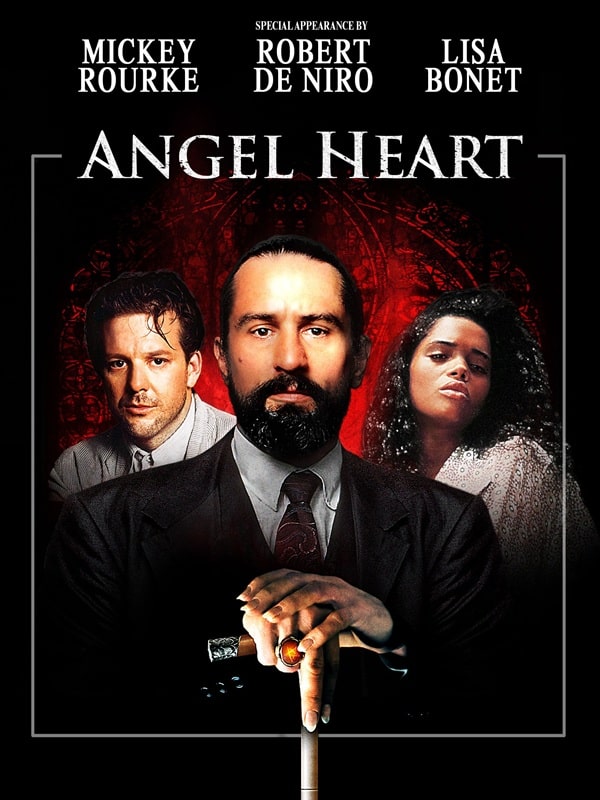 Angel Heart (Tri-Star Pictures, March 6, 1987)
Angel Heart (Tri-Star Pictures, March 6, 1987)
This is how my brain works sometimes.
This week Deadline reported that Robert De Niro will be starring in an upcoming crime drama for Netflix called The Whisper Man based on a novel by the same name. That made me think that when I last saw De Niro, the dude looked pretty old, and that starring in a multi-installment series for Netflix would be pretty taxing. That led me to IMDB to find out how old he really is (De Niro is 81), which resulted in going down the rabbit hole of his incredible career, which led me to Angel Heart (1987).
I had all but forgotten about this film, but the minute I read the name all this controversial stuff about it started resurfacing in my mind. Honestly, I couldn’t recall if Angel Heart was really all that controversial, or if I remembered it wrong and naturally this resulted in a lost afternoon reading everything about it I could get my hands on.
So, here we are and yes, the movie was steeped in controversy.
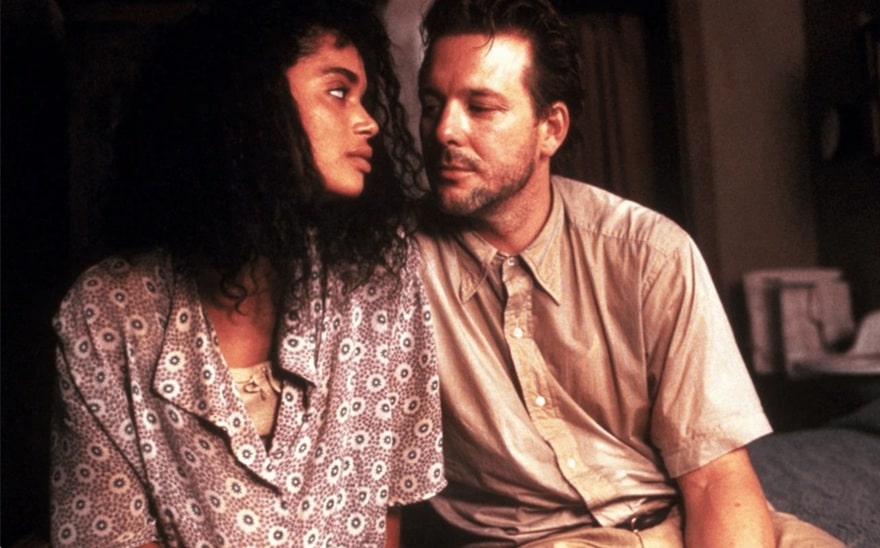 Mickey Rourke and Lisa Bonet in Angel Heart
Mickey Rourke and Lisa Bonet in Angel Heart
Directed by Alan Parker (Midnight Express) and starring the pre-cosmetic surgery hotness that was a young Mickey Rourke, Robert De Niro, and Lisa Bonet (one of those adorable Cosby Show kids), Angel Heart blended the genres of psychological thriller, neo-noir, and horror. Set in 1955 New Orleans, it tells the story of small-time private investigator Harry Angel (Rourke) who is hired by a man who calls himself Louis Cypher (De Niro) to track down a singer named Johnny Favorite.
The investigation takes Angel into the backwaters of the Louisiana bayou where he meets the luscious young Epiphany Proudfoot (Bonet), who also happens to be a voodoo priestess. Suddenly, the trail Angel is following becomes soaked in blood and gruesome murder. So, who is trying to keep Angel from finding his quarry?
To kick off the reasons Angel Heart became a cult classic, after it pretty much bombed at the box office, was that at the time Bonet was best known for her role as Denise Huxtable on The Cosby Show, a wholesome family sitcom. Bonet’s Angel Heart performance included a graphic sex scene and nudity, which led to backlash for her career and to her public image.
Though it didn’t exactly ruin her in Hollywood, Angel Heart made it challenging for Bonet to find roles that matched her previous success. Producers and casting agents often pigeonhole actresses based on public perception, and Bonet’s decision to take on such a provocative role led to her being seen as “too edgy” for mainstream projects (for another example, seee Elizabeth Berkley [Saved by the Bell] and her movie Showgirl [1995]).
While we’re on the topic of sex scenes, the most infamous Angel Heart controversy involved the raw sex scene between Rourke and Bonet. This scene, which featured nudity, blood, and disturbing imagery, pushed boundaries for its time, not the least of which was because of the revelation of an incestuous relationship between Rourke’s and Bonet’s characters. This plot twist, coupled with the explicitness of the scene, sparked outrage and made the film even more polarizing.
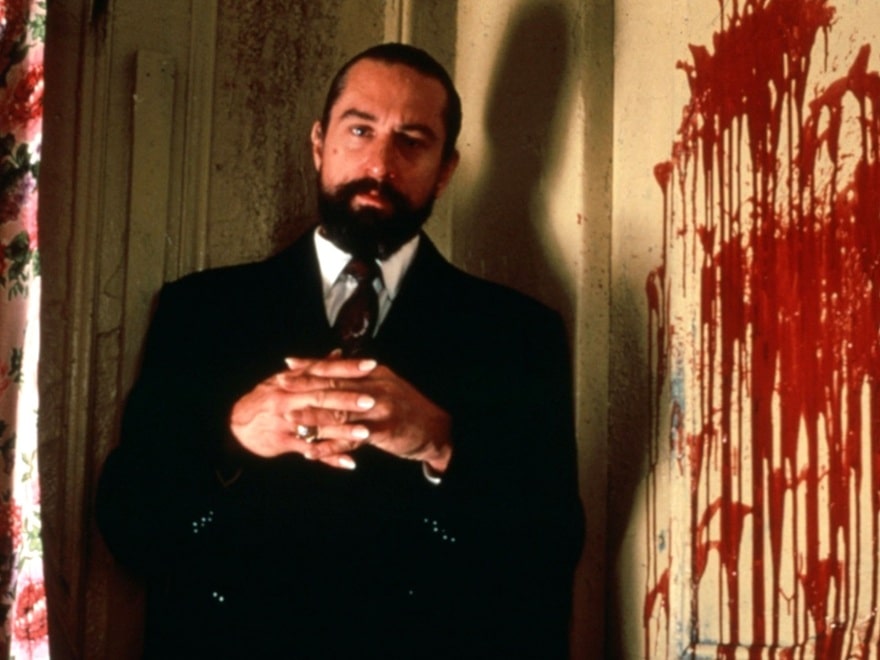 Robert De Niro as Louis Cyphre
Robert De Niro as Louis Cyphre
The film’s depiction of voodoo practices, combined with De Niro’s portrayal of Louis Cyphre (an alias for Lucifer if that hasn’t jumped out at you yet), upset religious groups to no end. De Niro’s performance, though praised by audiences for its eerie subtlety, drew vocal criticism for allegedly glamorizing the devil. Critics accused Angel Heart of promoting occultism and blasphemy, while others argued that the film perpetuated stereotypes about voodoo and Haitian culture, painting them as sinister or evil.
Then there was the violence. Angel Heart is graphically violent, with several brutal and unsettling death scenes, including one involving a character’s heart being ripped out and another being boiled alive in a large vat of jambalaya. The overall dark tones and the depiction of psychological torment left many viewers disturbed, especially as Harry Angel’s true identity and fate are revealed.
The Motion Picture Association of America (MPAA) initially gave the film an X rating. Alan Parker had to cut approximately 10 seconds of footage from Bonet and Rourke’s nude romp to secure an R rating, though many still found the final version shocking. Ironically all the goriest scenes remained intact. You’d never imagine De Niro eating a hard-boiled egg could be so unnerving.
 Mickey Rourke then and now
Mickey Rourke then and now
Yes, I immediately had to give Angel Heart a rewatch – it’s pretty much streaming everywhere. Frankly, I’ve always liked it in the same way I’ve always liked The Ninth Gate (1999) with Johnny Depp. Just suspend your disbelief and go there, provided you can get around the distraction of how the actors have changed (not just aged) in the years since.
Variety: Russell Rothberg to be showrunner for Swan Song!
News from Variety about the upcoming TV adaptation of Swan Song!
The series adaptation of the Robert McCammon novel “Swan Song” has found its writer, Variety has learned exclusively.
Russell Rothberg has boarded the project, which was first announced in January, to serve as writer, executive producer, and showrunner. The show is now being taken out to market.
Business Musings: How Entertainment Fits Into Our Lives
Please note: This originally went live on my Patreon page on Sunday night, January 26, 2025. Since then, even more crap has happened in the world and people are freaking out. (Freaking out, btw, does not help. Calm, deliberate, and calculated action helps, along with…well, read the post.) If you want to see most of my business posts these days, you’ll find them on Patreon. I’m only going to post a handful here.
How Entertainment Fits Into Our LivesI spent the day of 9/11 with the television pegged on CNN, while I talked on the phone and handled e-mail. At the time, Dean and I were traditionally published and a good 80% of our income came from New York City.
We had friends there, friend-family there, and so much business there. I spoke to people, searching for them, figuring out if they were okay or not (and, physically, they were). I informed my agent’s assistant that she was in an evacuation zone, and she needed to leave now, something her boss (who was in Connecticut) apparently hadn’t been willing to do. No one knew what the toxic smoke emanating from the buildings was going to do, so they were evacuating the entire area. I reminded her that she could work from home, because she was afraid she would lose her job if she left.
She got out and she got safe.
Dean, always the most level head in any emergency, grabbed every single extra book we had, along with the books and advanced reading copies that we had stacked up to trade in at Powell’s Bookstore in Portland, Oregon. At the time, we lived in Lincoln City, on the coast.
Dean packed the car and took off for Portland, over two hours away. Neither of us liked that he was going, but we felt he had to. At that moment, we had no idea if the attack was localized to the East Coast or if other major cities were going to get hit. We had no idea what would happen to the economy, especially if the attacks continued, and we had no idea if Dean would be safe as he headed to downtown Portland.
What he knew, and what I quickly realized, was that our entire income stream was about to dry up. We had some money in the bank, but not enough to get us through six months to a year (worst case).
Those ARCs and first editions that he brought to Powell’s were catnip for collectors and he got thousands of dollars for them.
The next morning, Powell’s shut down all book buying. Dean’s Hail Mary journey was prescient and would have been impossible if he had waited even 24 hours.
That money got us to January, which was when the first payments started trickling back out of New York City. He was smart, but he did have to spend the day listening to the chaos coming out of New York and D.C. We had cell phones, but most of us used landlines. Still, I kept him updated on what I knew, and after I reached everyone I could, I spent the day locked in horror, alone with the TV and all of those awful images—some of which no major network has replayed.
By the time he got home, we had to shut it all off. We couldn’t handle the stress anymore. We knew that the future was uncertain—bleak, difficult and frightening. For those of you who were children then or those of you who weren’t even born, this is what it felt like: We had no idea if those planes were the first volley in a war. We were catapulted from a familiar world with familiar patterns into one filled with chaos, uncertainty, death, and violence.
I do not remember what we had for dinner that night. Nor do I remember what we talked about if anything. I do remember that every single cable channel—even the ones that should have been showing classic movies—would break in with updates. Not that the movies were any comfort. Every one that had been scheduled was set in the before times, and some even had images of the World Trade Center—the still-standing World Trade Center, before the big disaster.
So there was no television option. But we had a streaming satellite radio subscription. I turned on one of the stations that just played music—no talk at all—and I think I left it on for days.
I had a book due in two weeks, which was almost laughable. That was the project I was working on. But I couldn’t focus on it. I did not return to my writing desk for ten days. By then, I knew that the book deadline was going to be extended (my editor was not in New York at that time; she had been in France), and I had time.
I wrote a short story called “June Sixteenth at Anna’s,” which was about 9/11 in a sideways way, but more than that, it was about worlds lost, moments that are forever gone, and are mostly impossible to recover. When it was published in Asimov’s in 2003, 9/11 was still close. The story finished third in the Reader’s Choice Awards and was chosen for a year’s best volume.
But I didn’t write the story for readers.
I wrote it for me. I had to clear my palate of the horrors I’d seen. I also had to work through that jolt of fear that happens to all of us when our life’s path suddenly takes a terrible turn.
After I wrote the story, I was able to return to the novel. I guess I had officially gone back to work.
But quieting my mind was harder. When there are blanket emergencies—things that happen on a national or worldwide scale—it’s hard to escape them. And sometimes, you shouldn’t escape them.
This past year, we had to deal with a lot of crap in a business we built lovingly for our own work. The betrayal and breach of trust that we suffered also had economic and practical ramifications, and we had to handle those quickly and with great attention.
I didn’t sleep much during that period (or after Dean shattered his shoulder or much with another emergency the year before that), and I didn’t have a lot of leisure. An hour of television at night, the occasional Aces basketball game, and then (stunningly to me) football in the fall provided a bit of distraction.
Mostly, though, I couldn’t afford to be completely distracted. I was in the middle of an emergency and I had to concentrate. When I was able to find a distractable moment, I needed to choose my reading wisely. I had to avoid the new or the challenging. I read a lot of mediocre romance and some rather terribly done mysteries, while waiting for my favorite authors to release new books. And even then, I would balk at some of the topics they had chosen and set the books aside for later.
I’m just getting to later now.
But this was an emergency that I was literally in the middle of. If I didn’t act correctly, make the right choices, and handle the problems in the right way, my business might crumble. Dean was right beside me as were Chris York and Stephanie Writt. I have no idea how we got through June, July, and August, but we did, and the business is better for it.
Friends of mine are going through something similar right now. I am writing this on Sunday night, as the City of Los Angeles and the surrounding areas are finally, finally getting rain after months of drought.
The fires that sprang up during the Santa Anna winds of January made many of my friends flee their homes. I followed on Facebook with some, because I’m not on Twitter. Others I communicated with by phone, and still others I couldn’t locate at all because they had a limited social media presence…and I didn’t feel comfortable calling them in the middle of an emergency. Let me rephrase: a fleeing for your life emergency. I contact friends during emergencies all the time, but if I know they’re in the middle of the crazy shit, I wait a day or so to see if they need something.
Most of my friends who are going through this aren’t hurting for money. They fled to hotels, and one friend noted on Facebook that he had paid for two weeks, just in case.
Not hurting for money makes one aspect of the crisis easier. It means that you have the ability to pay for two weeks in a hotel—any hotel. Sleeping in your car isn’t necessary. Trying to get to family or friends who can put you up (if they’re willing) isn’t necessary either. You can buy clothes and toothpaste, buy a carrier for your dog, and get food.
But it doesn’t help the emotional part. And that second weekend in January, when everything was burning, reminded me of the other disasters I’ve seen or been through: the TV coverage was relentless and it was almost everywhere.
People who had evacuated couldn’t find anything to rest their brains, if they wanted to, although it’s easier now with streaming. If they escaped with their laptops or their iPads or their phones, they could watch something.
At that point in a crisis, you need something mindless.
Eventually, though, you have to dig out. You have to repair the damage. You have to see the lay of the land.
For many, the presidential election has also precipitated a crisis. A lot of people unplugged and disappeared after the election, unable to face what was ahead. The rest of us soldiered on, although we’re handling the firehose of change differently than we did in 2017.
I know some of you are happy with the election. Please don’t tell me, because what’s bothering me the most right now is the blatant bigotry against anyone who isn’t cis, white, and male. If you can tolerate that, you’re free to leave without comment, because if you do comment about this particular point, I will block you.
I’m on social media and yes, in a bit of a left-wing bubble. And I’m seeing a lot of people call anything that is entertainment “bread and circuses.”
They’re wrong.
Entertainment is how we survive.
Yes, we all need to pay attention. We need to fight for our little corner of the universe, whatever that means. (You can see which corner of the universe I’m focusing on from my note about bigotry above.)
But we can’t be on alert twenty-four hours per day for the next few years. Or even for the next few months.
That way lies complete disaster. People can and do collapse from exhaustion in crisis situations (however they define that), and then they’re of no help at all. (Sometimes, as I mentioned above, you have no choice; you must run full speed ahead. But at a certain point, you have to stop running and start building.)
A surprising part of that exhaustion isn’t from lack of sleep; it’s from lack of rest.
The brain is an amazing thing. It can marshal defenses, activate the sympathetic nervous system, and get us through whatever we’re facing. But it’s taxing on the body, and not something we can sustain for years.
I wanted to dig a little into the science for you, but I’m not an expert. Instead, I found something from the Association of Critical Care Nurses. This blog post by Sarah Lorenzini explains the science of crisis response. She’s writing for critical care nurses, but the article applies to all of us.
She writes:
Maintaining your well-being is essential for mastering the SNS response. Practice self-care to mitigate stress and enhance resilience. Engage in activities that promote physical and mental well-being, such as exercise, mindfulness, hobbies and spending time with loved ones. Being tired or hypoglycemic exacerbates negative symptoms associated with the stress response. By nurturing yourself and prioritizing adequate rest, hydration and nutrition, you can maintain composure and sustain your ability to provide compassionate care in demanding situations.
Let me reiterate something buried in the middle of this post, for the “bread and circuses” crowd. She writes, Engage in activities that promote physical and mental well-being, such as exercise, mindfulness, hobbies and spending time with loved ones.
Hobbies. Reading, watching movies and TV, going to sporting events…are hobbies. And hobbies are essential for survival in tough times.
Understanding the science is important—at least to me—and I learned long ago about the importance of shutting off the mind and going “somewhere else” for a little while. Sometimes movies and TV do that, sometimes sports does, but nothing is better than a book or a short story.
(During the worst of our crises last summer, I could only focus on short stories. But they were a lovely distraction.)
I learned this during 9/11. I couldn’t read mystery novels or even romances because at that moment, I was so shaken I wasn’t sure if I believed in happily ever after.
I ended up reading made-up world fantasy novels. They are the actual definition of “somewhere else.” Not somewhere familiar either. Somewhere I’d never thought of.
Science fiction is the same, but at the time I couldn’t find anything long and immersive. I ended up reading a fantasy series that I had on my TBR pile.
It was that series that reminded me of the importance of escape.
Fiction is survival for people in difficult situations. Fiction is necessary.
And we can’t dictate what kind of fiction other people need.
When I was a child living in an abusive household, I consumed as much fiction as possible. Sometimes I needed the escape of a made-up world, but I also read a lot of scary books—many of the Gothic novels because I knew they had a happy ending. And those books reinforced that no matter how dark the world got, people could survive.
Interestingly enough, to me the reader at least, the people who survived were always the ones who took action. Yes, that’s a tenet of fiction. After all, who wants to read about a whining protagonist who does nothing and needs to be rescued at the end?
But it’s also consistent with our biology.
The critical care nurse writes this:
I understand the surge of hormones in response to an emergency and how paralyzing it can feel. However, I have learned to channel my SNS (sympathetic nervous system) to help optimize my performance as a nurse. Instead of perceiving the physical manifestations of stress as hindrances, I reframe them as signs that my body is preparing me for peak performance. I embrace the increased heart rate, rapid breathing and heightened senses as indicators that I am ready to act and make a difference.
Our job, as writers, is to give the people responding to a crisis—any crisis—that escape which will give them the right kind of rest. It might enable them to get an extra hour of sleep at night. It might help them relax just enough to calm down and then move forward.
What we do is extremely valuable.
We should not dismiss it as “bread and circuses,” something to be avoided in a crisis.
We should embrace it as the necessity that it is.
That’ll enable us to continue to write and it’ll allow us to make time for our own rest through whatever crises we experience in our lives.
Storytellers are essential.
So tell your stories, no matter what is going on in the world.
And read the kinds of stories you love, without guilt or judgement.
It’s a great way to take care of yourself and the world around you. Because we all need that little moment of rest.
“How Entertainment Fits Into Our Lives ,” copyright © 2025 by Kristine Kathryn Rusch.
Addendum added on February 1:
I’m currently reading the issue of The Hollywood Reporter that came out during the fires. It had this tidbit: Apparently LA Residents (even those who had been evacuated) flocked to the movies in the non-fire zones. People needed an escape.
https://www.hollywoodreporter.com/movies/movie-news/wildfires-movie-theaters-1236111782/
As one woman said, “What else are we going to do? I wanted to get away from it all.”
Just more evidence that entertainment is important, even in the tough times.
Spotlight on Enthralling “Once Was Willem” by M. R. Carey
Mark your calendars, LitStackers! Once Was Willem by M. R. Carey is in presale (the…
The post Spotlight on Enthralling “Once Was Willem” by M. R. Carey appeared first on LitStack.
On McPig's Wishlist - Paladin's Grace
 Paladin's Grace (The Saint of Steel #1)by T. Kingfisher
Paladin's Grace (The Saint of Steel #1)by T. KingfisherStephen's god died on the longest day of the year…
Three years later, Stephen is a broken paladin, living only for the chance to be useful before he dies. But all that changes when he encounters a fugitive named Grace in an alley and witnesses an assassination attempt gone wrong. Now the pair must navigate a web of treachery, beset on all sides by spies and poisoners, while a cryptic killer stalks one step behind…
From the Hugo and Nebula Award winning author of Swordheart and The Twisted Ones comes a saga of murder, magic, and love on the far side of despair.
A Masterful Three Novella Original Anthology: The New Atlantis, edited by Robert Silverberg
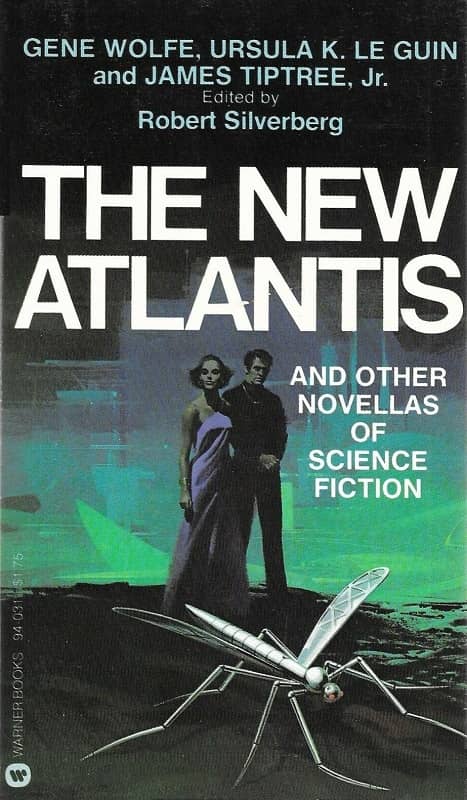
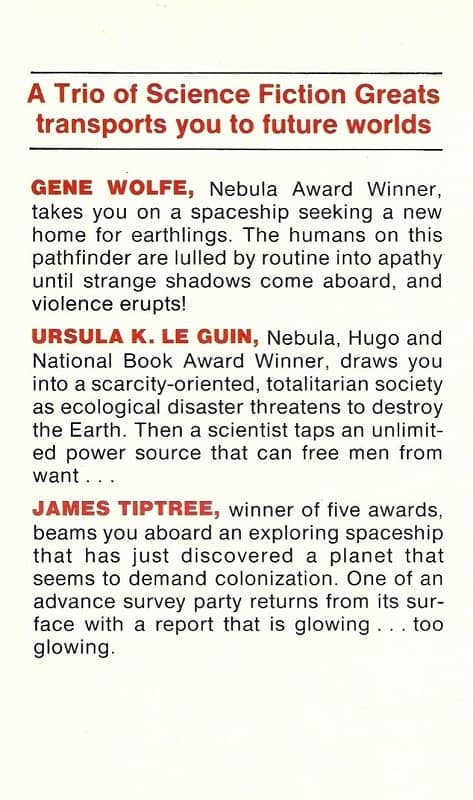
The New Atlantis (Warner Books paperback reprint, 1978). Cover by Lou Feck
My latest look at a book from the 1970s treats a major anthology from 1975. The New Atlantis and Other Novellas collects three long stories: “Silhouette,” by Gene Wolfe; “The New Atlantis,” by Ursula K. Le Guin, and “A Momentary Taste of Being,” by James Tiptree, Jr. The project received plenty of notice at awards time – the book as a whole was fifth in the Locus Poll for Best Anthology, “A Momentary Taste of Being” and “Silhouette” were 7th and 9th, respectively, in the Locus Poll for Best Novella, while “The New Atlantis” won the Locus Poll for Best Novelette, and received a Hugo nomination in that category, and both it and the Tiptree also got Nebula nominations.
Let’s look at the individual stories first.
“Silhouette” by Gene WolfeGene Wolfe was a remarkable writer at all lengths — he produced brilliant short-shorts, short stories, novelettes, novellas, novels, series of novels, even a series of series of novels. “Silhouette,” at about 20,000 words, is one of his novellas — and it may be that the novella was his ideal length.
[Click the images for masterful versions.]
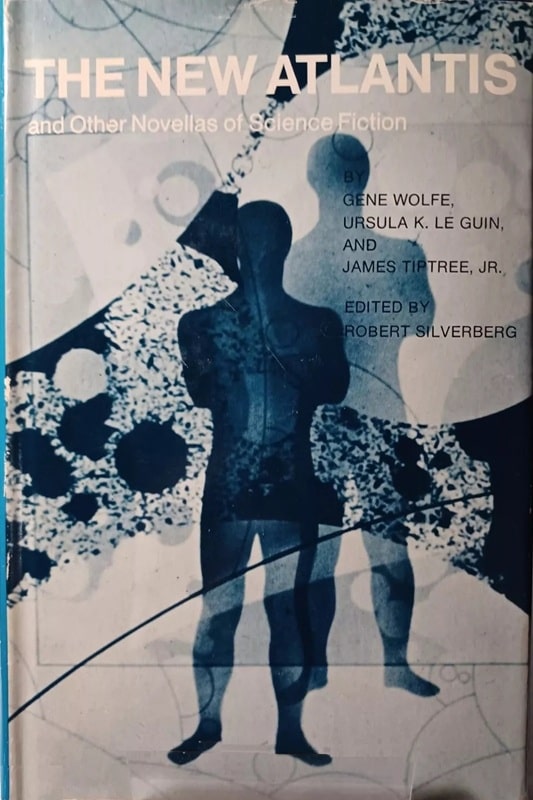 The New Atlantis hardcover edition (Hawthorn Books/Science Fiction Book Club, 1990). Cover by Jorge Hernandez
The New Atlantis hardcover edition (Hawthorn Books/Science Fiction Book Club, 1990). Cover by Jorge Hernandez
At any rate he wrote some 15 novellas, ranging from “The Fifth Head of Cerberus” in 1972, to “Memorare” in 2007; and of these at least “The Fifth Head of Cerberus,” “The Death of Dr. Island,” “Tracking Song,” “The Eyeflash Miracles,” “Seven American Nights,” and “The Ziggurat” rank among the great novellas in SF history. I don’t rank “Silhouette” quite with those stories, but it is a powerful and original piece.
A starship has reached a planet called Neuerrdraht, and the crew are considering whether it is suitable for human habitation. The viewpoint character is Johann, one of the officers, who is skeptical about the prospect of colonization. The ship is deteriorating, however, and the Captain is insistent. There are other factions, including a group that worships the ship’s computer… We get a flavor of life on the ship — a certain grunginess, oppressiveness, with features such as women (except for the Captain) being required to sleep with officers whenever available. Johann has dreams of walking on the surface of the planet, and he is visited by a — shadow? his shadow? something from the planet? A silhouette, at any rate!
The story continues in a disturbing fashion, as the atmosphere on the ship becomes darker. There’s a sense that the ship’s decay mirrors the decay on Earth, from which they had escaped. Johann finds himself confronting the computer-worshippers, and a group that seems intent on mutiny, and people ready to hurt him if he won’t cooperate. With the ambiguous help of the shadow being, he gets through all this, and then comes the actual mutiny, with chaotic and unexpected results.
This is a very good story, but as I said not quite Wolfe at his best. It lacks the truly mysterious aspect that I love most in Wolfe’s work. As I suggest above, I think the best way to read it is to see conditions on the ship as a sort of metaphor — a reflection, even a silhouette — of conditions on the Earth they left. The ship is full of class divisions, and sexual divisions: it’s a particularly oppressive place for women, it seems. And there is no reason to expect colonizing Neuerrdraht will solve anything.
“The New Atlantis” by Ursula K. Le GuinThis is the shortest of these stories, at perhaps 10,000 words. It is set in a ruined near future (to 1975) US, in which climate change has caused sea levels to rise and some parts of the coast are submerged. The country is ruled by a sort of corporatist tyranny, which to my eyes had both right-wing and left-wing elements. The narrator lives in Portland, and her husband has just returned from a prison camp — but they have to be careful, as in this future marriage is illegal. She is a musician, and her husband is a mathematician. And there are rumors of new continents emerging from the ocean.
The narrative alternates passages in the narrator’s POV, with passages from the POV of a mysterious underwater being. The narrator tells of ordinary life in this dismal future: practices her music in the bathroom to frustrate the bug they discovered there, and her husband has friends over, talking dangerously about politics and also about science — in particular, a discovery they have made of a very cheap and portable energy source. The corporatist rulers have a monopoly on energy, and there isn’t enough available to most people. Free energy will be wonderful but destabilizing to the government. . Meanwhile, the sea level keeps rising, and her husband’s risks are clearly threatening their life together. All along the underwater being is telling of what it witnesses, and it’s more or less clear that this is an entity on the rising continent.
The conclusion is mournful, ultimately. There is a sense — ambiguous perhaps — that humanity has irretrievably messed up the planet, and that the “New Atlantis,” which might have been a new sanctuary perhaps? 0r might represent a purified world? — will either be empty or available for humanity’s successors. (But really that’s my speculation purely.)
It’s obvious that aspects of this story seem prescient now, though the story certainly isn’t (and wasn’t trying to be) an accurate prediction of our times. It’s more of an impressionistic, and somewhat despairing, depiction of a decay Le Guin foresaw. And it’s beautifully written.
“A Momentary Taste of Being” by James Tiptree, Jr.This story is by far the longest story here, at some 37,000 words, occupying well over half the book. The setup is curiously similar to that of Wolfe’s “Silhouette”: a starship, the Centaur, has come from a ravaged Earth hoping to find a suitable planet to colonize. As the ship’s name suggests, the solar system being investigated is Alpha Centauri, and as the action opens, Dr. Lory Kaye is in quarantine, having just returned from an expedition to a promising planet. She returned alone, leaving the fellow members of the expedition on the planet, which seems to be a wonderful place, in her telling. She has also brought back a sample of alien life, a large plant-like being. Her ship, and she herself, are quarantined. The story is told from the POV of her brother, Dr. Aaron Kaye, the chief medical officer.
Lory’s tale is received suspiciously by some of the officers. There is minimal actual data retrieved from the planet. There are some hints of what seems to have been violence, or at least disagreements between the various planetary explorers. And there seem to be strange effects on everyone who gets anywhere near the alien plant. But everyone is exhausted by their long mission (10 years) and there is a sense that this is the last chance for the people of Earth. Aaron himself is one of the more skeptical about the planet’s prospects, as is their alcoholic captain. But others desperately want to immediately colonize the planet and send a signal to Earth for others to follow. One man tells Aaron of his plans to set himself up as a sort of petty ruler, complete with an harem (that would include Aaron’s lover Solange.) Aaron, too, is torn by his loyalty to his sister, with whom he had an extended incestuous relationship through their teens.
The story is a rather a slow burn — with a very extended telling of the final day or so of Lory’s quarantine, and of the plans to study the alien plant she brought back; as well as some flashback to Aaron and Lory’s past, and depictions of Aaron’s interactions with other crew members, including a horribly injured man named Tighe, as well as Captain Yellaston, whose alcohol is supplied by Aaron; and the various other officers with their motivations, and descriptions of the somewhat unstable mental state of just about everyone.
But it all culminates in a really powerful final scene, as the nature of the alien plant creature is revealed, and Tiptree’s metaphor for what is really going on becomes clear. It’s a very Tiptree-like ending, and, like so many of her stories, it’s fundamentally about sex and death. Part of me wishes it was somewhat shorter, but perhaps the drawn out beginning is necessary to set up the conclusion. It’s not Tiptree’s greatest story, but it’s one of her most characteristic, I think, and it’s really despairingly effective. Tiptree’s vision, it seems to me, never exactly sunny, became darker and darker throughout the ’70s, culminating in 1980 with “Slow Music,” often called her last great story.
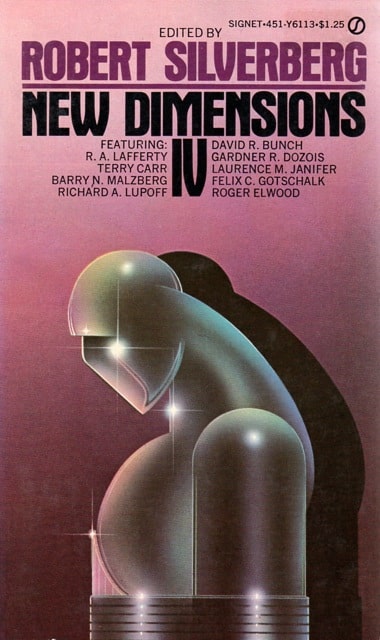
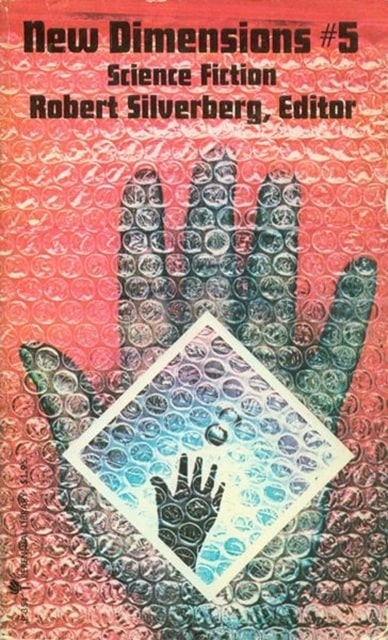
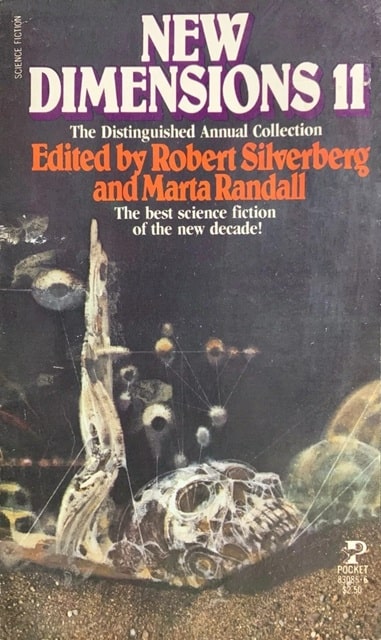
Three volumes of Robert Silverberg’s New Dimensions: IV (Signet, October 1974),
5 (Perennial Library, September 1976), and 11 (edited with Marta Randall,
Pocket Books, July 1980). Cover art: unknown, Joe Harris, Richard Powers
This anthology highlights an aspect of Silverberg’s career for which he perhaps hasn’t gotten the credit he deserves: his influence on SF as an editor and anthologist. And it is possible that the single best original anthology Robert Silverberg produced was this one — The New Atlantis. The three stories are by three of the greatest SF writers of all time, each at the absolute height of their powers. (And, as Silverberg notes in his introduction, all three of these writers came to SF fairly late.)
Silverberg’s editorial contributions go well beyond this book. His original anthology series New Dimensions is remarkable as well, featuring a great many of the best stories of its time. The massive original anthology Epoch (co-edited by Roger Elwood) was far better than its Elwood-stained reputation suggests. He produced many more original anthologies (see sidebar below).
He was also a prolific anthologist of older stories, most notably The Science Fiction Hall of Fame, Volume I, and a wonderful set of 7 books called Alpha. He published quite a few more short anthologies of older SF, and some later doorstops, both original (as with the Legends books, and Far Horizons, plus three books following on the late Terry Carr’s Universe series that he co-edited with his wife Karen Haber), and also reprint books, particularly two Arbor House collections of Great Short Stories and Great Short Novels.
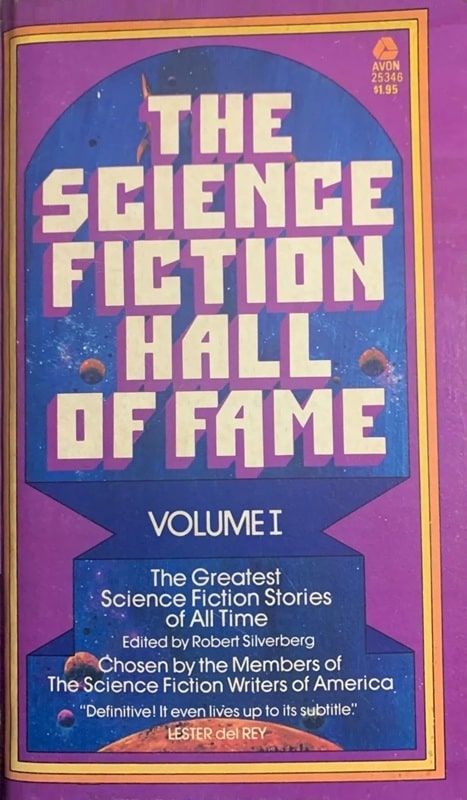
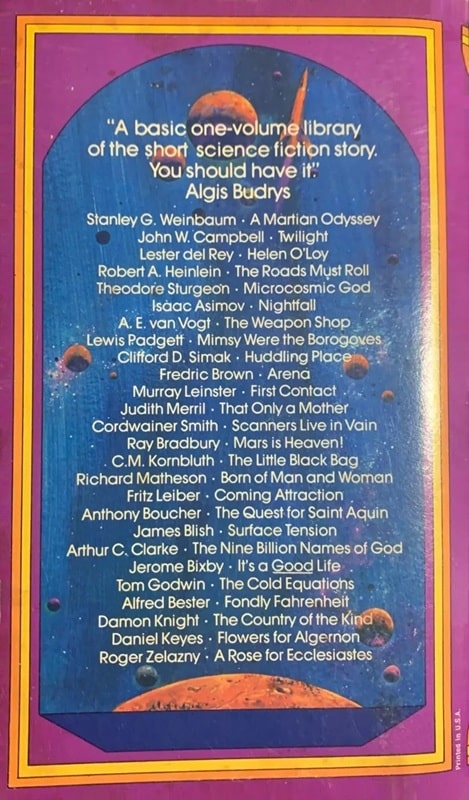
The Science Fiction Hall of Fame, Volume I, edited by Robert Silverberg (Avon, July 1971).
In the decade from 1969 to 1979, Robert Silverberg edited 11 anthologies of original novellas. (One book had four stories.) At the same time Silverberg was producing his original anthology series New Dimensions, and his reprint series Alpha. And that’s not to mention his own fiction — despite a retirement during this period he published some 15 novels and dozens of short stories.
Relatively few examples in the three novella format come from other editors. Silverberg’s primary rival (as I perceive it), Terry Carr, did just one “three novella” book, though a very good one, An Exaltation of Stars. The super prolific Roger Elwood published three, Futurelove, A World Named Cleopatra (with Poul Anderson), and In the Wake of Man. That last book, which had stories by R. A. Lafferty, and Walter F. Moudy, is one of Elwood’s very best, particularly as it features one of Gene Wolfe’s greatest novellas, “Tracking Song.”
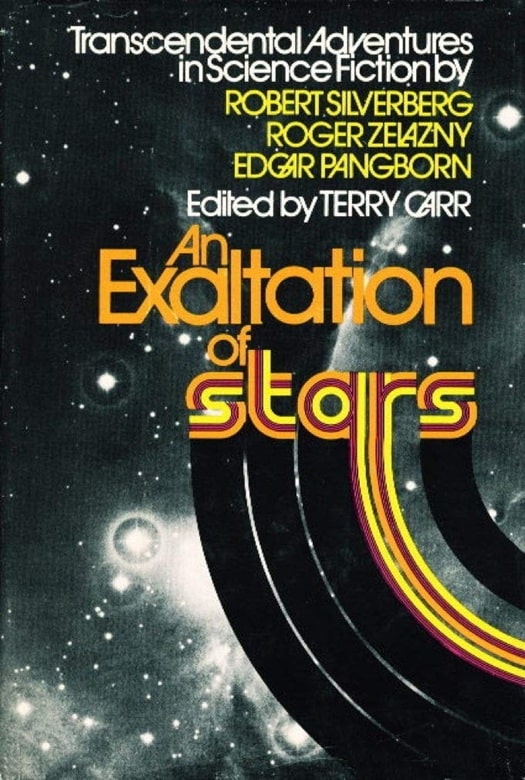
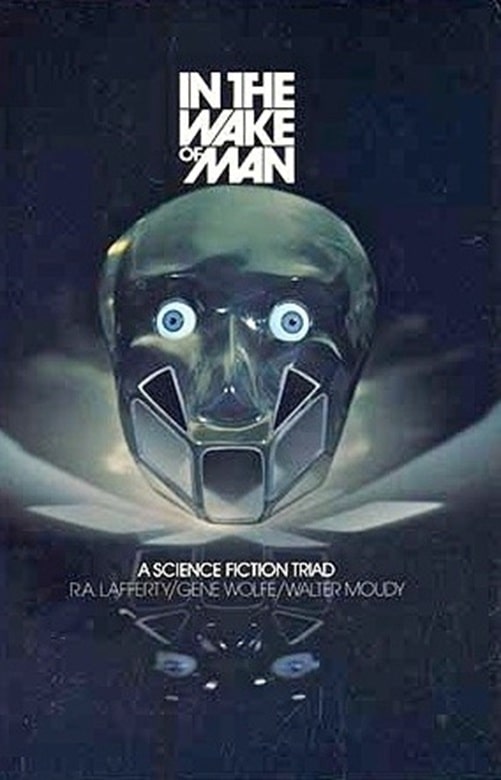
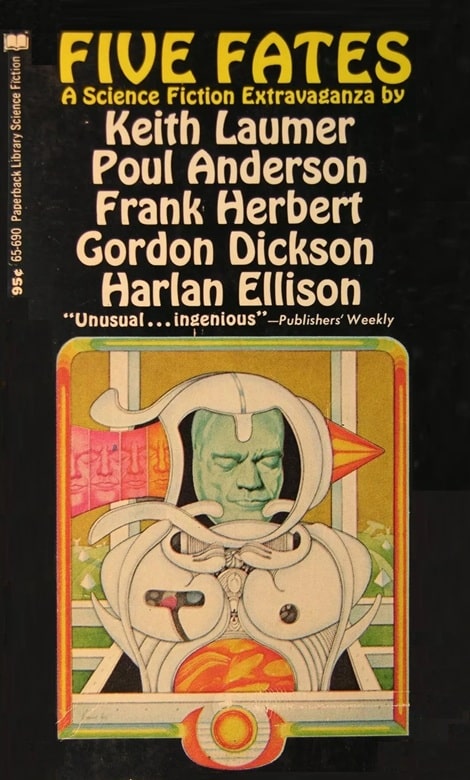
Other anthologies in a novella format: An Exaltation of Stars, edited by Terry Carr (Simon &
Schuster, June 1973), In the Wake of Man, edited by Roger Elwood (Bobbs-Merrill Company,
August 1975), and Five Fates, edited by Keith Laumer (Paperback Library, September 1971).
Cover art by Adelson & Eichinger, Nick Aristovulos, Lorraine Fox
The Anderson collaboration has four stories, all set on the title world, a creation of Anderson’s. (In this sense it mildly resembles the Twayne Triplets of the 1950s, which collected three novellas on the same subject, based on an introductory essay. Several of those books were planned, but in the end only two appeared, Witches Three and The Petrified Planet.) One other anthology of interest is a 1970 book put together by Keith Laumer, Five Fates, in which five writers continued a brief introduction by Laumer, in which a man goes to a Euthanasia center and begins to die — each writer then extrapolates what may happen to this man after (?) death.
Here are the eleven “novella” books Silverberg did.
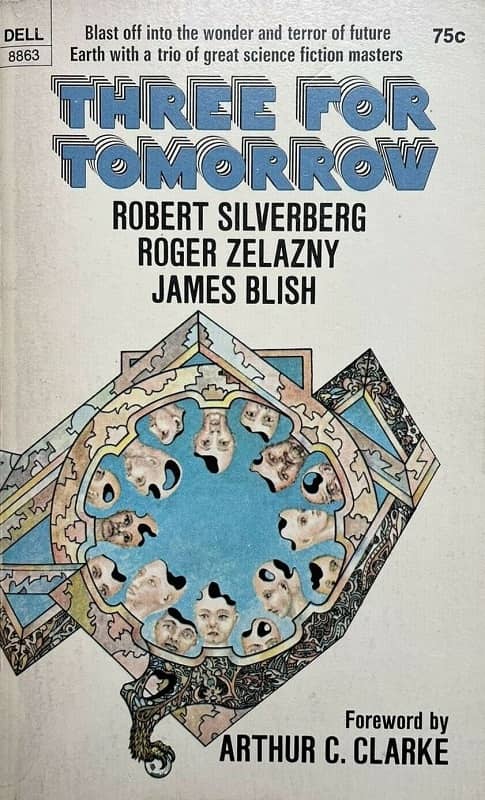
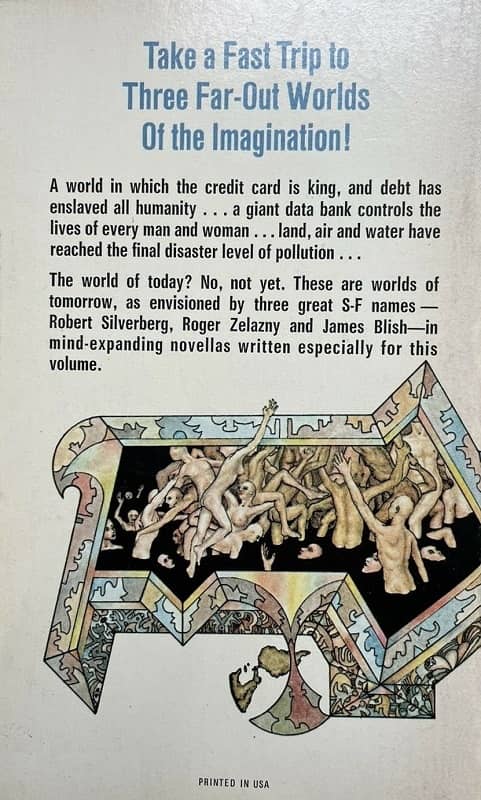
Three for Tomorrow (Dell, 1970). Cover uncredited
How It Was When the Past Went Away • novella by Robert Silverberg
The Eve of RUMOKO • novella by Roger Zelazny
We All Die Naked • novelette by James Blish
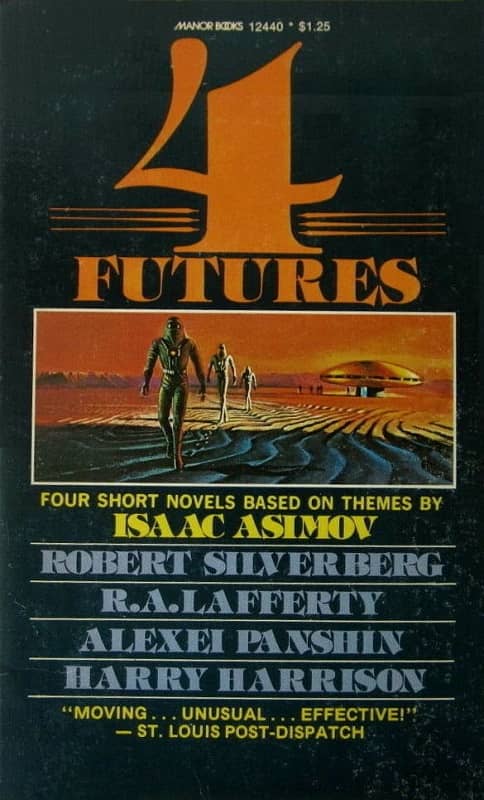

4 Futures (Manor Books, 1976 ). Cover by Bruce Pennington
Ishmael Into the Barrens • novelette by R. A. Lafferty
Brave Newer World • novelette by Harry Harrison
How Can We Sink When We Can Fly? • novelette by Alexei Panshin
Going • novella by Robert Silverberg
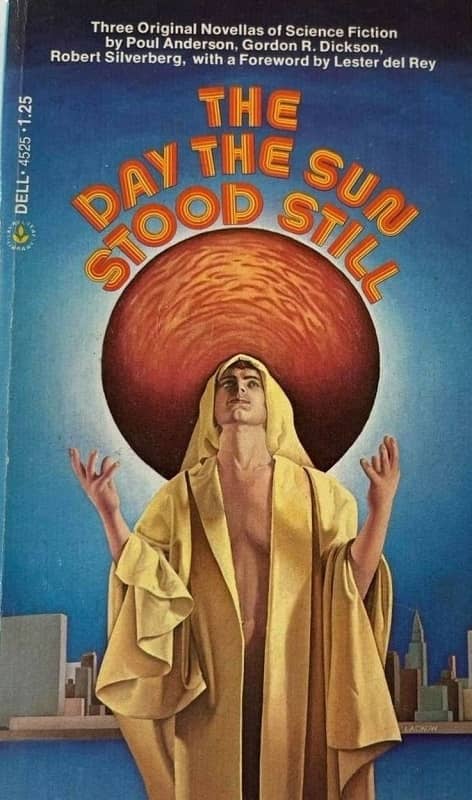
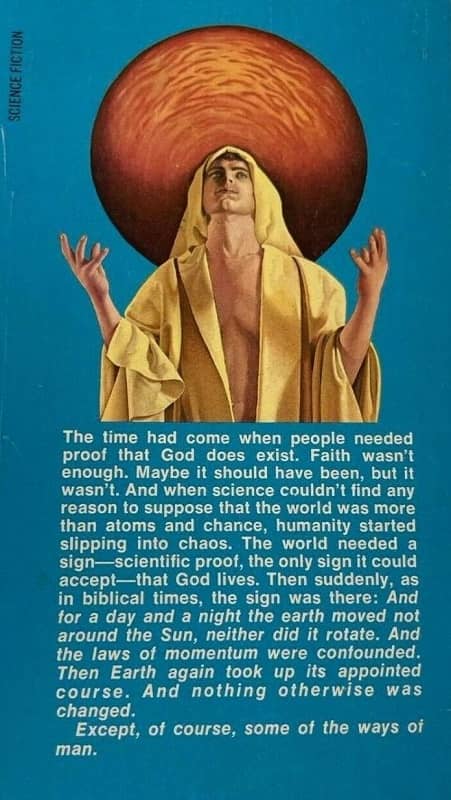
The Day the Sun Stood Still (Dell, 1975). Cover by Andy Lackow
Thomas the Proclaimer • novella by Robert Silverberg
A Chapter of Revelation • novella by Poul Anderson
Things Which Are Caesar’s • novella by Gordon R. Dickson
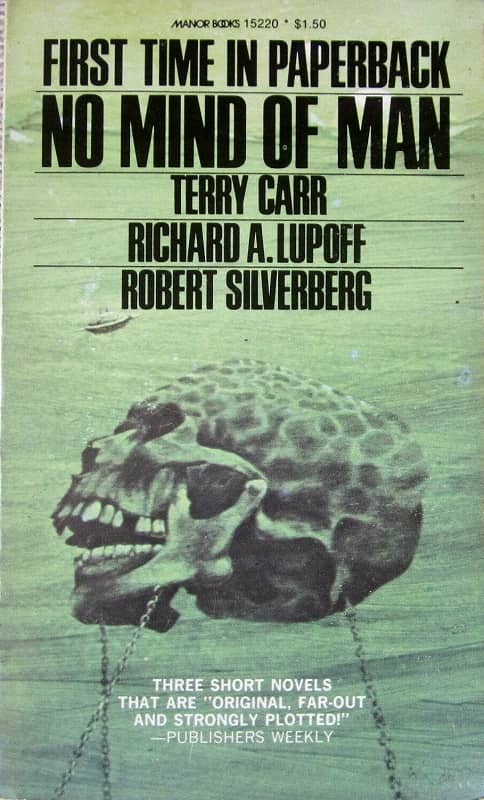
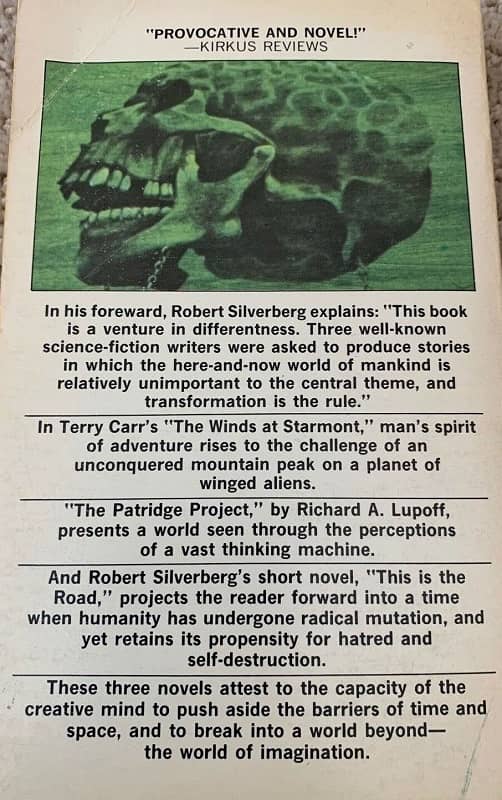
No Mind of Man (Manor Books, 1973). Cover uncredited
The Winds at Starmont • novella by Terry Carr
The Partridge Project • novella by Richard A. Lupoff
This Is the Road • novella by Robert Silverberg
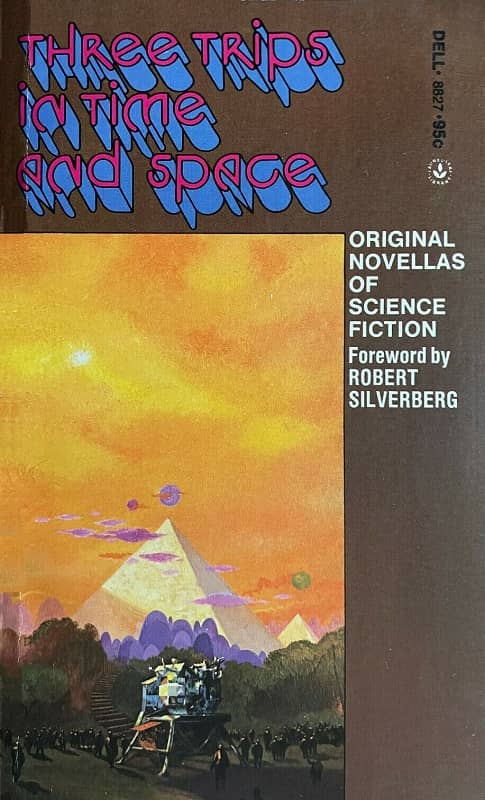
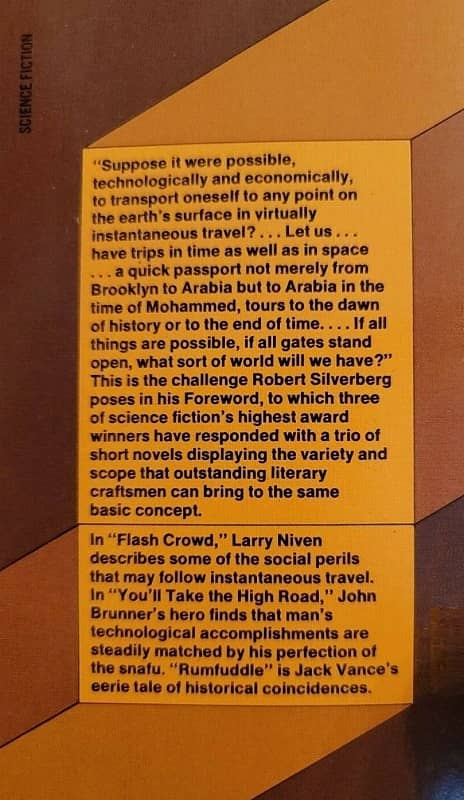
Three Trips in Time and Space (Dell, 1974). Cover by Paul Lehr
Flash Crowd • novella by Larry Niven
You’ll Take the High Road • novella by John Brunner
Rumfuddle • novella by Jack Vance
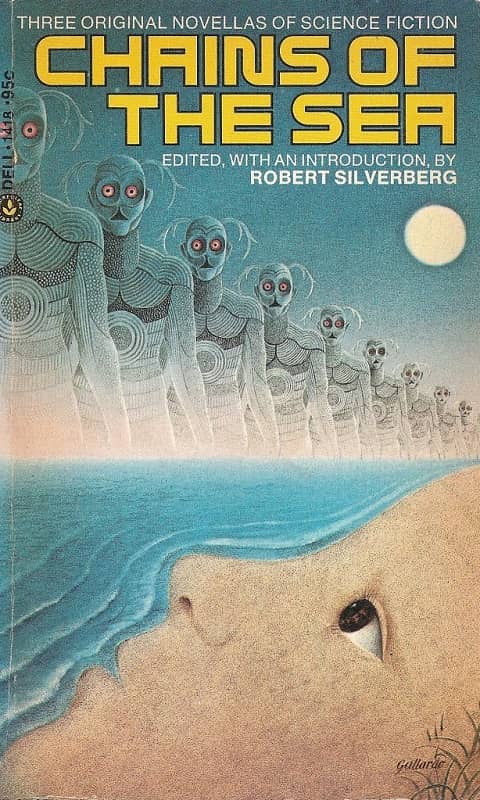
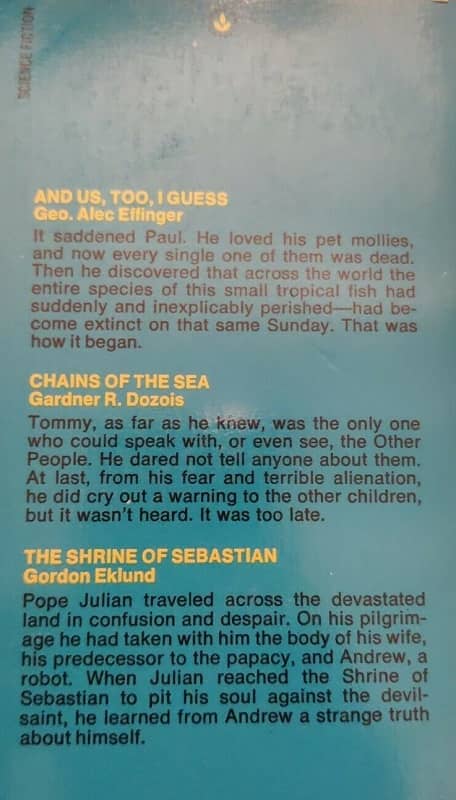
Chains of the Sea (Dell, 1974). Cover by Gervasio Gallardo
And Us, Too, I Guess • novella by George Alec Effinger
Chains of the Sea • novella by Gardner Dozois
The Shrine of Sebastian • novella by Gordon Eklund
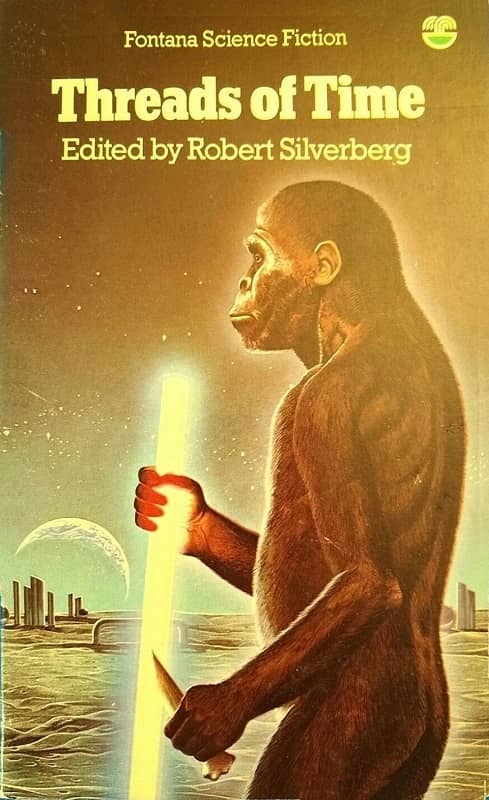
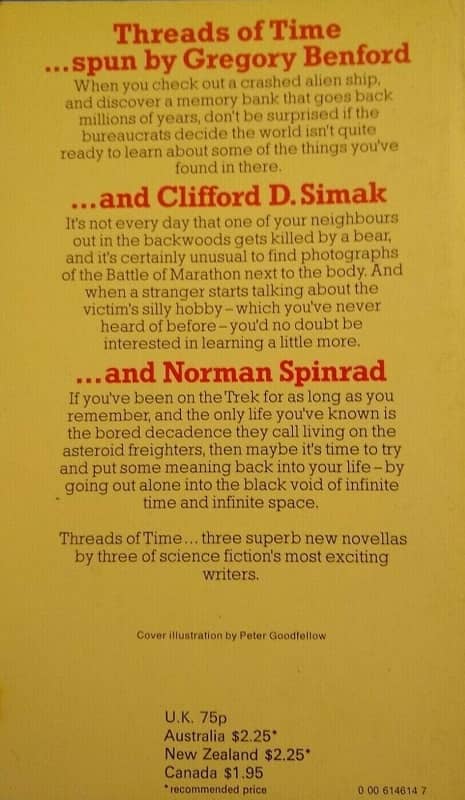
Threads of Time (Fontana, 1977). Cover by Peter Goodfellow
Threads of Time • novella by Gregory Benford
The Marathon Photograph • novella by Clifford D. Simak
Riding the Torch • novella by Norman Spinrad


The New Atlantis (Warner Books, 1978). Cover by Lou Feck
Silhouette • novella by Gene Wolfe
The New Atlantis • novelette by Ursula K. Le Guin
A Momentary Taste of Being • novella by James Tiptree, Jr.
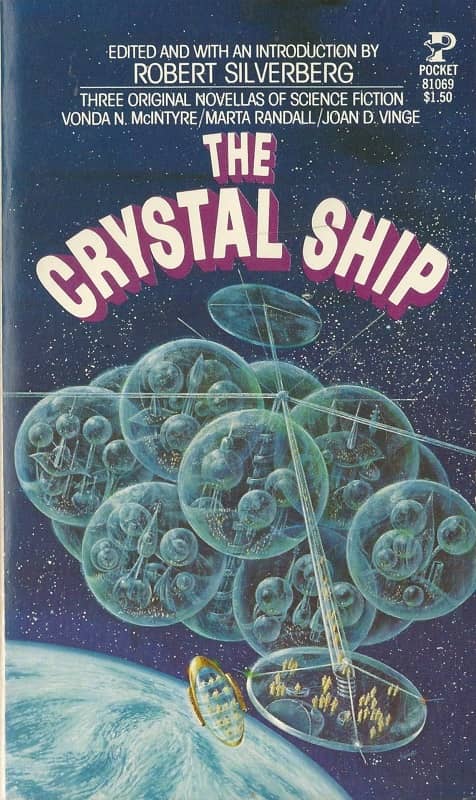
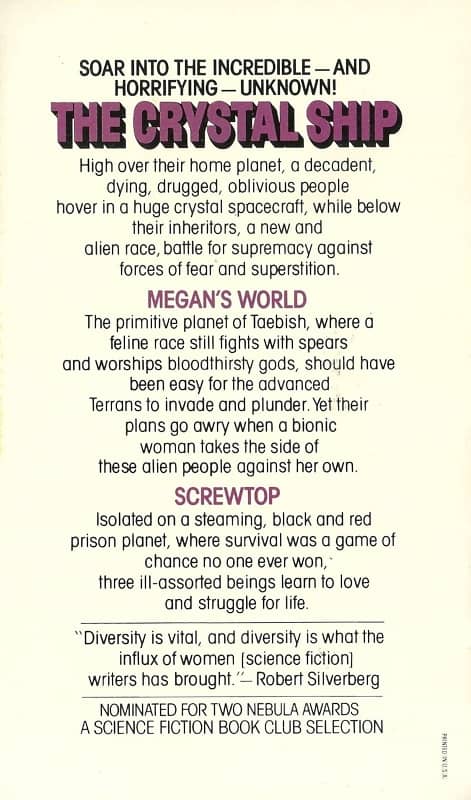
The Crystal Ship (Pocket Books, 1977). Cover byNorman Adams
The Crystal Ship • novella by Joan D. Vinge
Megan’s World • novella by Marta Randall
Screwtop • novella by Vonda N. McIntyre
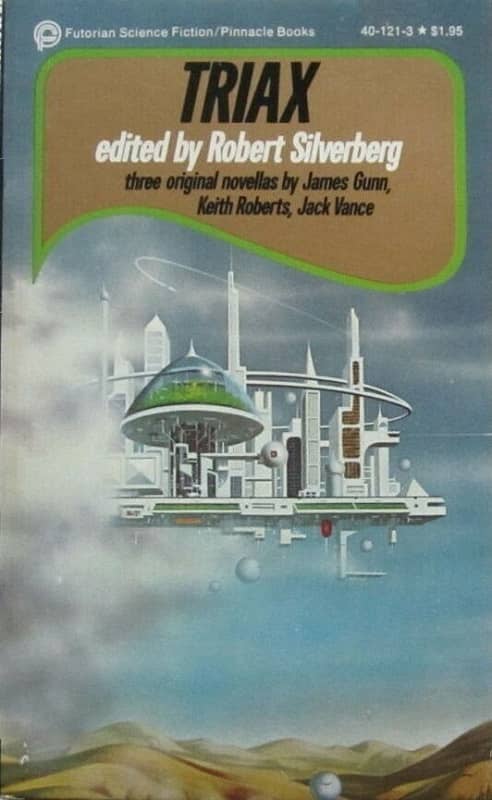
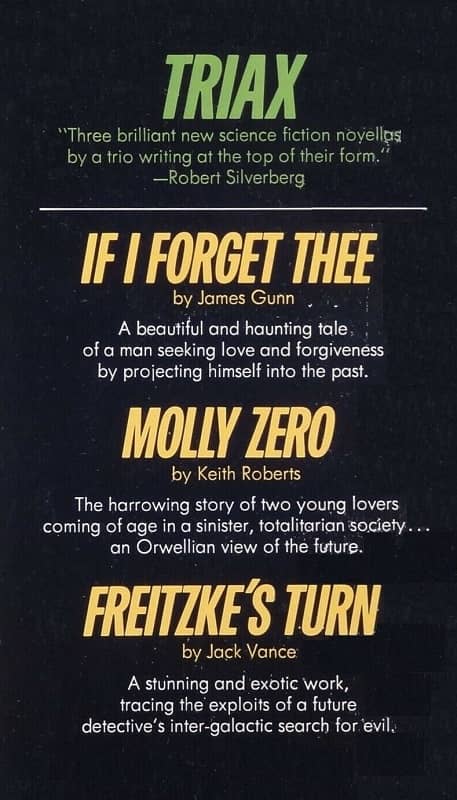
Triax (Pinnacle, 1977). Covers by Randy Weidner
Molly Zero • novella by Keith Roberts
If I Forget Thee • novella by James E. Gunn
Freitzke’s Turn • novella by Jack Vance
The Edge of Space hardcover edition (Elsevier/Nelson Books, 1979). Wraparound cover by Freff
The Edge of Space (1979)The King’s Dogs • novella by Phyllis Gotlieb
In the Blood • novella by Glenn Chang
Acts of Love • novella by Mark J. McGarry
Rich Horton’s last article for us was an obituary for Barry N. Malzberg. His website is Strange at Ecbatan. Rich has written over 200 articles for Black Gate, see them all here.
DOGE- Supernatural Division (a fun satire story)
A Dirty Betrayal
Not long ago, I made this blanket for Kid 2.

It was made with Stylecraft DK yarn. I don’t really care for acrylic normally. If you ever felt a skein of Red Heart, it’s rough and scratchy and it kills my hands. But Stylecraft, although it is acrylic, is buttery soft, cloud-like, and shiny, and it comes in a million of colors, which is why I bought it from UK.
It is now time for Kid 1’s blanket, so I confidently ordered a bunch of yarn for it. Imagine my surprise when it arrived, and I felt it, and it feels like a horrible, scratchy mess. I am squishing this yarn and blergh.
So here I am, staring at the yarn and wondering if I have lost the whole bag of my marbles. Given all the things that are happening right now in my life, that was a distinct possibility.
I ended up googling it and guess what? Stylecraft moved their production from Turkey to West Yorkshire. Yarn produced in Turkey? Super-soft. Yarn produced in West Yorkshire? Scratchy mess.
I hate it. I hate it, I hate it, I hate it.
I’m actively controlling my irritation right now, because this is a tiny drop into a very full cup.
So I need a new yarn.
- Preferably DK weight
- Very soft on hands
- Must have many colors
- Should be durable enough to be washed and dried frequently, because Kid 1 will wash that blanket all the time. That’s the way she rolls.
It can be a blend of cotton and acrylic or acrylic. I don’t mind paying more as long as it’s soft, because if I’m going to invest that much time in it, I want it to be nice from my daughter and I want my hands to survive. Right now crocheting is off the menu for a bit, because the hands hurt, but I would like to buy the yarn and be ready.
The post A Dirty Betrayal first appeared on ILONA ANDREWS.
7 Author Shoutouts | Authors We Love To Recommend
Here are 7 Author Shoutouts for this week. Find your favorite author or discover an…
The post 7 Author Shoutouts | Authors We Love To Recommend appeared first on LitStack.
Party Planning Can Be Murder - Early Book Review
 Party Planning Can Be Murder: A Party Planner Mysteryby Kerry Schafer/Kerry Anne King
Party Planning Can Be Murder: A Party Planner Mysteryby Kerry Schafer/Kerry Anne KingWhat is it about:Wish List: pick up my pills from the pharmacy, plan my party, be there when I die…
Despite a few harrowing incidents with nervy Bridezillas, Addy Winters’ small town party planning business has been murder free – until now. But then, she’s never before been hired to throw a star-studded after-death party for a client who has their death scheduled on their calendar.
When Leno Masterson—former classmate, now legendary rocker with a flair for drama—turns up dead four days earlier than he’d planned, Addy suspects that someone helped him along. Sure, he left a melodramatic goodbye letter and his right-to-die paperwork is all in order, but even when the coroner rules natural causes, Addy isn’t buying it.
Addy’s family and friends – and Leno’s smolderingly hot brother Owen – warn her that she’s diving in over her head, and they’re right. She’s woefully unprepared for either the media onslaught or the secrets the people she thought she knew are hiding. But nothing is going to stop her from getting justice for Leno – and throwing a killer party while she’s at it.
If you love your mysteries with humor, heart, and a side of romance, this is your next must-read. Perfect for fans of Finlay Donovan and The Thursday Murder Club!
What did I think of it:There are some authors you follow to whatever genre they decide to write next. Kerry Schafer is one of those authors. When she switched from Urban Fantasy & Paranormal Thrillers to Women's Fiction as Kerry Anne King, I followed and loved those books as well. Her next release will be by both pen names and is a Murder Mystery!
You bet I jumped on the chance to be an early/ARC reader and let me tell you I devoured this book!
I was drawn in and emotionally invested from the first chapter. I fell in love with Addy and wanted her to succeed in everything she does. (I also thought some very not nice things about her family, apart from her brother and grandmother.)
I was already enjoying myself very much with this story when Leno turns up dead and the mystery begins. And I can tell you: there's tons of things Addy has to figure out to discover what happened to Leno. I couldn't stop reading: I needed to know who or what caused Leno's death.
The writing (as with every book Kerry has written) is so good in my opinion. There's lots of humorous situations and the writing fits those perfectly.
Voodoo Bride wants me to mention Owen: according to her Owen was the dreamiest and coolest character in the book. I myself can't say if he is indeed the dreamiest, but he for sure was a character I really didn't want to see ending up as the killer.
I'm not going to spoil the ending of course, but you can bet I want more books in what I hope will become a long series. I'll also grab the print version to hug and reread once this releases next month.
Why should you read it:It's an awesome Mystery read!
Expected publication: March 11, 2025
Review: Murder by Memory by Olivia Waite
 Buy Murder by Memory
OFFICIAL AUTHOR BIO: Olivia Waite writes queer science fiction, fantasy, historical romance, and essays. She is the romance fiction columnist for the New York Times Book Review.
Buy Murder by Memory
OFFICIAL AUTHOR BIO: Olivia Waite writes queer science fiction, fantasy, historical romance, and essays. She is the romance fiction columnist for the New York Times Book Review.FORMAT/INFO: Murder by Memory will be published by Tordotcom on March 18th, 2025. It is 112 pages long. It is available in ebook, hardcover, and audiobook formats.
OVERVIEW/ANALYSIS: When Dorothy Gentleman, ship's detective, wakes up in a body that isn't hers, she's more than a little annoyed. After all, she's supposed to be retired, her mind resting in the ship's Library until she decides to print a body again. And even if she'd chosen to wake up, she should be in a fresh body all her own. But there's been a murder on the ship, and what's worse, someone is deleting the memory archives from the Library itself - something that should be impossible.
Murder by Memory is a fluffy fun little appetizer that left me longing for a deeper dive into this world. The mystery itself is pretty straight forward. Dorothy goes from point A to B to C in fairly quick succession, following the clues on a mostly linear path. It's not going to scatter red herrings on your trail or give you a cast of suspects to consider. In fact, the mystery is less about the Who than it is about the Why and the How.
Instead, I was much more intrigued with puzzling out the ship the murder takes place on. The H.M.S. Fairweather is on a thousand year journey to a new planet. But with the technology to back up a person's mind, it's not a traditional generation ship; there isn't a constant turnover of populace because a person can simply print themselves into a fresh body when their old body gives out. This opens up a whole host of fascinating societal questions that Murder by Memory only barely begins to touch on, but it was enough of a glimpse that I wanted to know more.
I was also impressed by the way the author quickly sketched out her core cast of characters, from Dorothy herself to Ralphie her well-meaning but not always sensible nephew to his mysterious bartender boyfriend. They don't have deep backstories given the length of the novella, but I got enough of a sense of them that I wanted to spend more time with them, as much as I wanted to explore the ship.
CONCLUSION: Murder by Memory is like an episode of a weekly crime procedural. You'll know most of the beats, but you'll enjoy it anyway for the comfort of the familiar, and you'll want to return the cozy cast of characters. As this is the start of a new sci-fi mystery series, I'm definitely looking forward to more adventures in this world, but I do find myself wishing this were a main course instead of a snack.
What a Croc, Part II
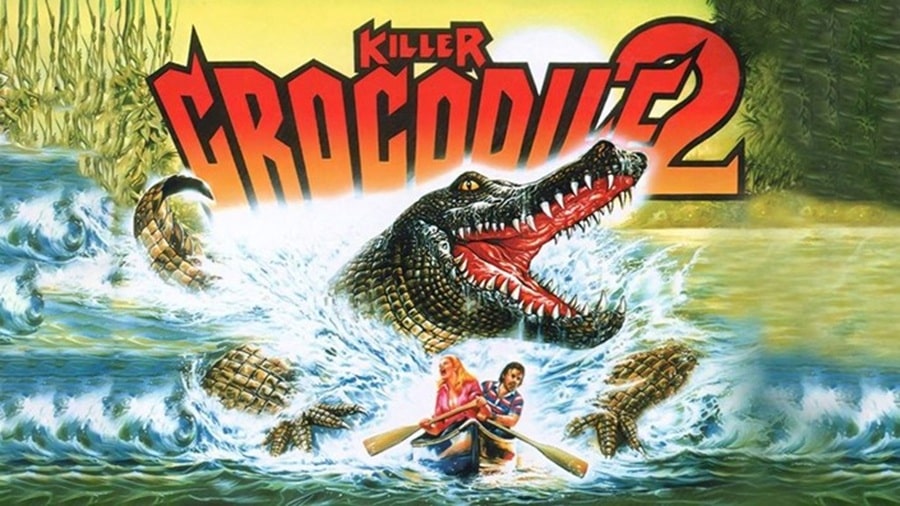 Killer Crocodile 2 (Fulvia Film, 1990)
Killer Crocodile 2 (Fulvia Film, 1990)
My next watch-a-thon is a favourite genre: crocs and gators. Unfortunately, this means the pickings are a bit slim, as I’ve already seen most of them, but I’ve managed to dig up 15 so far (supplemented with a Gila Monster and a couple of Komodos), and I’m sure the intended list of 20 will materialize as streaming services start suggesting titles.
Killer Crocodile 2 (1990) TubiCroc or gator? Crocodile. Again.
Real or faker? A hilarious puppet. The same one.
Any good? A direct follow on from the first story, this time the offspring of the first puppet is doing the chewing. Nefarious types are still dumping toxic waste, thrill seekers are still inexplicably wakeboarding in the world’s muddiest river, and ladies are still getting their kit off for a leaden leading man. Actually, the sexy pillow talk is a highlight. “Don’t you know that fear and near death situations stimulate and heighten a man’s reproductive organs?” Phwoar, steady on, love, you had me at ‘Don’t’.
[Click the images for gator-sized versions.]
The first film featured an unsettling attack on a small boy, but this one ups the ante by having a whole canoe-load of kids get eaten while a nun prays for salvation. Glorious hokum.
6/10
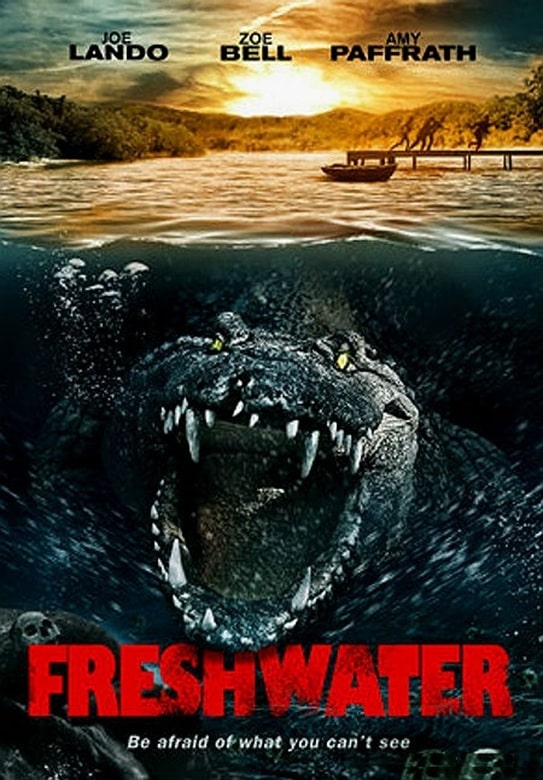
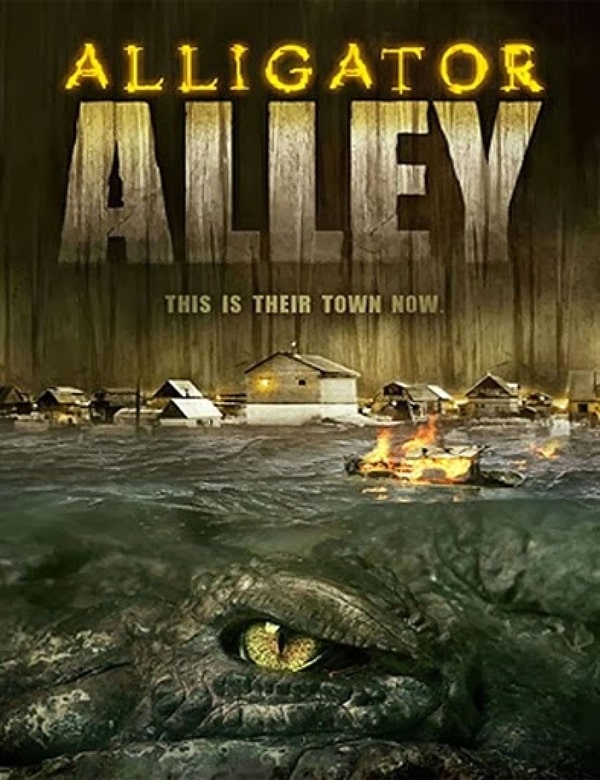
Freshwater (MultiVisionnaire, February 26, 2016) and Alligator Alley (Active Entertainment, 2013)
Croc or gator? Gator, possibly.
Real or faker? Let’s just say, when we do see a gator, it’s rubbish.
Any good? I’m torn, and not in a good way. There’s an awful lot wrong with this one, the script, the directing, the editing, the score (dear God, that score), most of the acting, the effects, and yet it tries something different (no spoilers, but it’s not what I was expecting) and I applaud the ballsy ending.
However, when the intended humor falls flat but your audience laughs at everything else, that ain’t good. Makes for a good drinking game if you are counting poor decisions (the first being to watch this optimistically).
5/10
Alligator Alley (2013) YouTubeCroc or gator? Gators!
Real or faker? Reasonably dodgy CG.
Any good? Also known as Ragin Cajun Redneck Gators, you know exactly what to expect going into this SyFy slice of grilled ham, and yet it upends those expectations with a hearty fart in the face. Toxic moonshine mutates gators into dart firing rascals whose bites turn folks into more gators (I kid you not). It’s all set against the backdrop of a family feud down south, and is as ludicrous as you might imagine.
It’s rubbish, but it’s daft rubbish, which is about as good as it gets these days, so I’m not hating it.
6/10
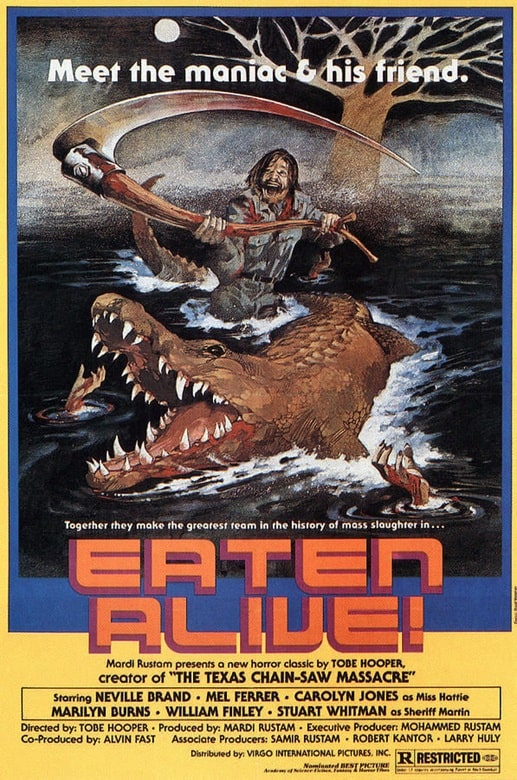
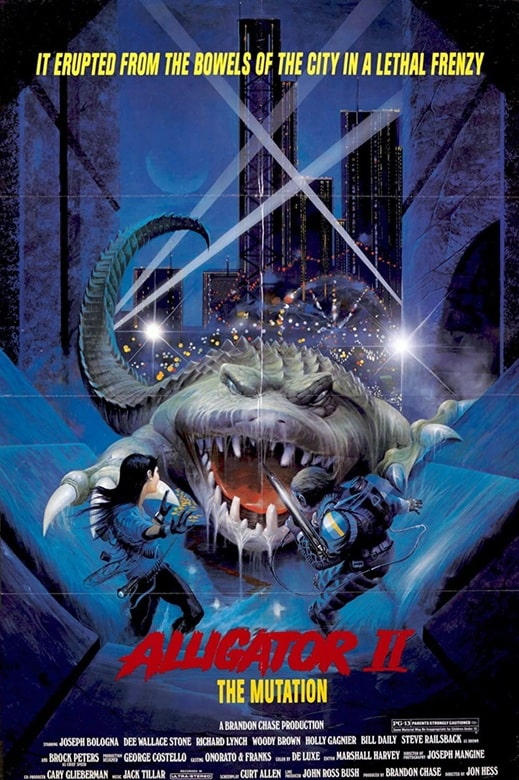
Eaten Alive (Mars Productions, October 18, 1976) and Alligator II: The Mutation (New Line Cinema, June 5, 1991)
Croc or gator? Nile Croc!
Real or faker? Cute papier mache monster.
Any good? Some good has come out of this ill-considered project, for I have finally watched the missing Tobe Hooper film in my life — a film banned in the UK until 1998 as part of Mary Whitehouse’s Video Nasty apocalypse. Though tame by today’s standards, the film does come with a warning for modern audiences as besides a bit of gore, it contains racial slurs and attempted rape.
This is Robert Englund’s first film role, and his big screen intro is “My name’s Buck, and I’m here to fuck.” Funny to think that he was roomies with Mark Hamill at the time, who was busy on his own little film.
The entire film is shot on a soundstage, and although the grimy motel is impressive enough, the exterior shots have an unearthly quality to them, surreal, dreamlike, bathed in red neon and resembling the last days. It’s atmospheric as all heck, with killer sound design, but it might be an uncomfortable watch for some (women are only present to get undressed). Neville Brand as the Norman Bates-ish ‘Judd’ is excellent, and the croc itself gets to do some fun chomping.
8/10
Alligator 2: The Mutation (1991) YouTubeCroc or gator? Alligator.
Real or faker? Stock footage and a rubbish puppet.
Any good? 11 years after the excellent and enjoyable first movie, someone decided to remake it, but make it boring. This film is missing two key ingredients, Robert Forster and a decent alligator.
Richard Lynch, Steve Railsback and Dee Wallace are welcome additions, but even they can’t save this dull ordeal. The story is the same as the first — a sewer alligator grows big and mean due to toxic waste, a corrupt businessman throws a party, rinse, repeat. However, where the first film kept its tongue in its cheek and actually showed us a big ol’ alligator, this one relegates its rubbish effects to the dark of the sewers, ensuring we see nothing for most of the film. Dull.
4/10
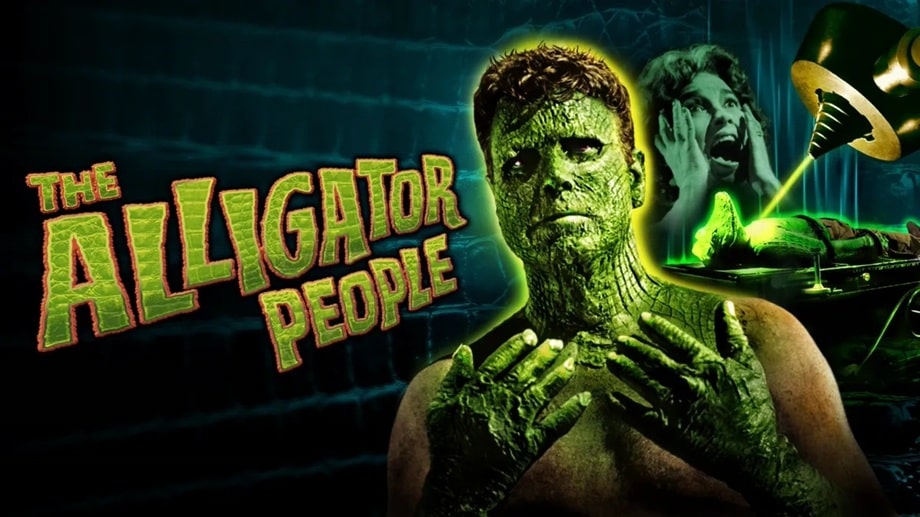 The Alligator People (20th Century Fox, July 22, 1959)
The Alligator People (1959) Disney+
The Alligator People (20th Century Fox, July 22, 1959)
The Alligator People (1959) Disney+
Croc or gator? Alligator people!
Real or faker? Real gators and some great makeup.
Any good? One of those classics that somehow passed me by — I suspect the hokey still used in every book didn’t inspire much confidence in me — but I was horribly mistaken. Far from being the B-movie cheesefest I was expecting, it was surprisingly compelling, with a decent plot, lovely writing (the narration is poetic) and makeup by none other than Ben Nye and Dick Smith!
Lon Chaney is creepy as all heck, Beverly Garland is lovely, and the whole affair drips atmosphere and dangly moss. There’s a bit of abuse aimed at some (real) gators, so animal lovers beware, but I ended up both enthralled and charmed and I’m very happy to finally tuck this one away.
8/10
Previous Murkey Movie surveys from Neil Baker include:
What a Croc, Part I
Prehistrionics
Jumping the Shark
Alien Overlords
Biggus Footus
I Like Big Bugs and I Cannot Lie
The Weird, Weird West
Warrior Women Watch-a-thon
Neil Baker’s last article for us was What a Croc, Part I. Neil spends his days watching dodgy movies, most of them terrible, in the hope that you might be inspired to watch them too. He is often asked why he doesn’t watch ‘proper’ films, and he honestly doesn’t have a good answer. He is an author, illustrator, outdoor educator and owner of April Moon Books (AprilMoonBooks.com).
Meet Marble Grant
Just a quick little post to let you all know that Dean’s Kickstarter for his marvelous Marble Grant stories has just gone live. There’s a lot of goodies here in addition to the books. You’ll find discounted workshops and a lot of short stories.
Take a look at the video I finished over the weekend, and see if Marble Grant is right for you.





Recent comments